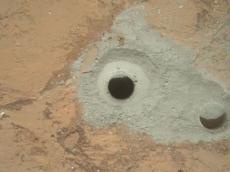|
|
TODAY.AZ / Weird / Interesting
NASA's Curiosity becomes first robot to drill another planet
12 February 2013 [11:43] - TODAY.AZ
 America’s car on Mars is finally being allowed to do what it was designed to do--fire up its hammer drill and bore into the Red Planet. After 182 sols (Martian days) of work, the the first robot equipped to take a bite out of another world got its first taste. To be sure, the Mars rover Curiosity has done some amazing things already, but this has to be pretty satisfying for the engineers who built it. It’s like having a coupe that can hit top speeds of 200 MPH, but you can’t do that yet because it might not be safe--but then suddenly you can!
America’s car on Mars is finally being allowed to do what it was designed to do--fire up its hammer drill and bore into the Red Planet. After 182 sols (Martian days) of work, the the first robot equipped to take a bite out of another world got its first taste. To be sure, the Mars rover Curiosity has done some amazing things already, but this has to be pretty satisfying for the engineers who built it. It’s like having a coupe that can hit top speeds of 200 MPH, but you can’t do that yet because it might not be safe--but then suddenly you can!Curiosity ran some tests last week before making its first hole Friday, and beaming back data to Earth on Saturday. The fresh hole is 2.5 inches deep and about 0.63 inches (1.6 cm) wide. The target rock is called “John Klein,” and it’s a flat exposed piece of bedrock in the Yellowknife Bay region of Gale Crater on Mars.
This rock is interesting to scientists because they believe it holds evidence about extinct wet environments on Mars. Curiosity is uniquely equipped to study the rock’s insides to find out about its past.
Along with boring through rock, the drill sucks up the dirt it produces. Rock dust travels up flutes in the drill bit and is stored in chambers until Curiosity is ready to use it. Like it did with its first scoop samples, Curiosity will swish dirt around in its sample mechanisms to make sure it rinses away any possible Earth contamination. Then its robotic arm will take the powder out of the drill assembly and put it into the scoop mechanism, which will sift it around to screen out any particles bigger than six-thousandths of an inch across. Then the very fine-grained powder sample will go into Curiosity’s X-ray machine and oven to be tested.
Planetary scientists hope to find out what minerals are present within John Klein, which can tell them about how the rock formed--whether it was in a wet environment, a salty environment, and so on. The main goal is to find out whether Gale Crater could have ever been a hospitable place for life. Scientists were thrilled about the drilling operation, according to NASA.
“This is the biggest milestone accomplishment for the Curiosity team since the sky-crane landing last August, another proud day for America,” said John Grunsfeld, associate administrator for NASA’s Science Mission Directorate.
Scientists will be working on the drill powder analysis during the next few days.
/POPSCI/
URL: http://www.today.az/news/interesting/118965.html
 Print version
Print version
Views: 1663
Connect with us. Get latest news and updates.
See Also
- 06 December 2024 [22:20]
Are scented candles harmful to health? - 23 November 2024 [14:11]
Magnitude 4.5 earthquake hits Azerbaijan's Lachin - 20 November 2024 [23:30]
Launch vehicle with prototype of Starship made its sixth test flight - 27 October 2024 [09:00]
Fuel prices expected to rise in Sweden - 24 October 2024 [19:14]
Turkiye strikes terror targets in Iraq and Syria - 23 October 2024 [23:46]
Kazakhstan supplied almost entire volume of oil planned for 2024 to Germany in 9 months - 23 October 2024 [22:17]
Taiwan reported passage of Chinese Navy aircraft carrier near island - 23 October 2024 [21:50]
Russia remains largest oil supplier to India - 16 October 2024 [17:54]
Gamesummit co-founder shares insights on future of gaming industry in Azerbaijan [EXCLUSIVE] - 12 October 2024 [18:27]
TikTok cuts jobs, turns to AI for content moderation
Most Popular
 IDPs return to rebuilt Shusha as part of Great Return State Program
IDPs return to rebuilt Shusha as part of Great Return State Program
 Pashinyan plants a pig for the Armenians
Pashinyan plants a pig for the Armenians
 Azerbaijan, Russia inks agreement on Development of Transit Freight Transportation
Azerbaijan, Russia inks agreement on Development of Transit Freight Transportation
 Sweden's Climate and Environment Minister calls for Shein and Temu to be banned in country
Sweden's Climate and Environment Minister calls for Shein and Temu to be banned in country
 President Ilham Aliyev's remarks in his interview with Dmitry Kiselev in spotlight of world media
President Ilham Aliyev's remarks in his interview with Dmitry Kiselev in spotlight of world media
 S. Korea to launch 3rd homegrown military spy satellite
S. Korea to launch 3rd homegrown military spy satellite
 U.S. finalizes US$4.7 bln in CHIPS Act subsidy to Samsung Electronics
U.S. finalizes US$4.7 bln in CHIPS Act subsidy to Samsung Electronics
